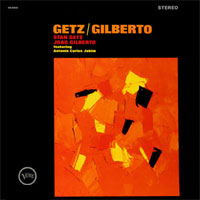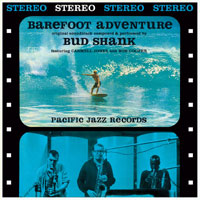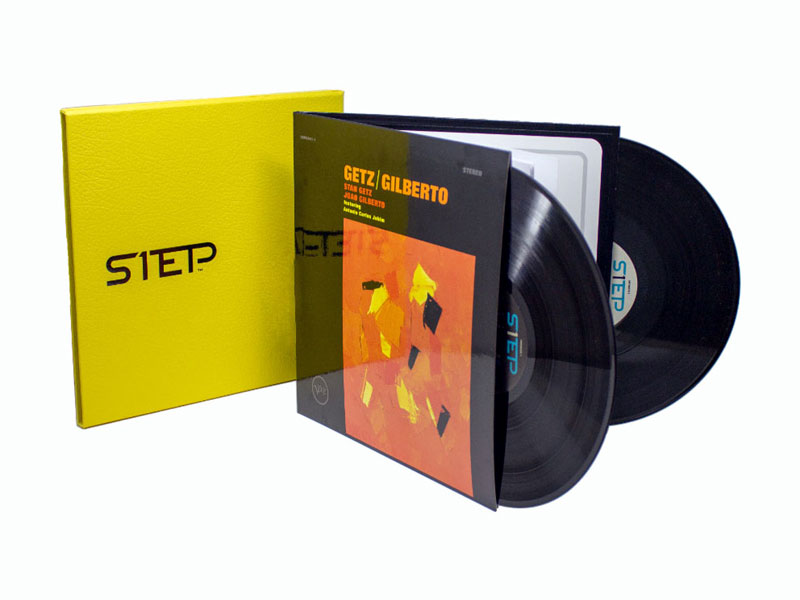Stan Getz and Joćo Gilberto • Getz/Gilberto Verve/Impex Records IMP6041-1 Bud Shank • Barefoot Adventure Pacific Jazz/Impex Records IMP6048
mpex Records’ two recent jazz releases include one record that almost everyone owns multiple copies of, and a second that few have heard of. Among audiophile jazz best-sellers, Getz/Gilberto stands in rarified company, with only Kind of Blue and Time Out providing any true competition, although with shifting tastes among audiophiles over the past quarter century, a few other Miles Davis and John Coltrane titles are changing the equation and adding to the list of records that are both jazz masterpieces and audiophile favorites. However, Getz/Gilberto has been issued in over 350 versions since 1964. The original album clocks in at slightly over a half hour, and its eight cuts, all composed by Antonio Carlos Jobim, are so familiar that even jazz haters can identify the album in a blindfold test. Try finding someone who does not know the lyrics to its most celebrated song, "The Girl From Ipanema." It was not the first jazz recording of Brazilian music, but the all-Brazilian supporting cast delivered the masterpiece that made the rise of Brazilian music seem inevitable. Phil Ramone recorded Getz/Gilberto at A&R Studios in New York in 1963, and the sound of the album has always been celebrated as among jazz-recording elite. But something funny happened on the way to the coliseum. The original pressing was mastered from Ramone’s three-track session tapes, but it became such a monster hit that recording engineer Ramone and director of engineering Val Valentine created a two-track production master that was used for future releases. Either intentionally or inadvertently, the channels were reversed on that production master. For the next couple of decades, new releases were pressed with the channels reversed, and jazz fans accepted that as the correct orientation. In the 1990s, audiophile labels discovered the album, and some chose the three-track orientation. In 1994, Mobile Fidelity reissued vinyl [Verve/Mobile Fidelity MFSL 1-208] and a gold CD [Verve/Mobile Fidelity UDCD 607] that reverted to the original orientation. Speakers Corner’s 1999 LP [Verve/Speakers Corner VG-8545] followed the reversed plan, and Analogue Productions' 2011 remastering at 45rpm [Verve/Analogue Productions AP-8545] and 2020 version at 33rpm [Verve/Analogue Productions AYER 69001] went with the original channel layout. Over the decades much ink has been spilled about which is more “original” and which sounds better. Over the years I have owned almost every version, including mono, in multiple copies. Keep in mind that the recording was not made with the musicians lined up on the stage. In fact, they sat in a semi-circle in the modestly sized studio, with the piano on one end and Gilberto and Getz at the other. So the soundstage is itself a studio artifact and neither orientation gives you a true depiction of how the musicians were lined up on a stage. Impex chose to go with the reversed orientation, reasoning that most listeners grew up listening to Getz/Gilberto that way. What is the best-sounding Getz/Gilberto? As a starting point, the album has always sounded as good as any jazz album can be expected to, with one caveat: it lacks the seamless soundstage of the best of the best, like Kind of Blue. Regardless of whether you are listening to one channel orientation or the other, the placement of the instruments is somewhat unnatural. It is not as obviously “right, left center,” like many contemporaneous recordings, but astute listeners intuitively know that Phil Ramone's idol, Fred Plaut, might have pulled off a better soundstage. But that is a minor quibble given the remarkable qualities of the recording, the gorgeous tonal quality of Getz’s horn, the immediacy of the strings of Gilberto’s guitar, and, most of all, every nuance of Astrud Gilberto’s voice. These attributes were obvious on Verve’s original pressings, both before and after the channel switch. They were not improved on by either Mobile Fidelity or Speakers Corner LPs, but in the Analogue Productions 45rpm version stepped to the front of the class. It improved the sense of air around all the instruments. This version was mastered by George Marino, shortly before he passed away. An SACD [Verve/Analogue Productions CVRJ 8545 SA] was released from this same mastering. In 2020, the 33rpm version was released. Both are still available and recommended. Although the hybrid SACD is from the same mastering, it sounds different -- as though the echo chamber was exaggerated on the digital but not the vinyl versions. In terms of digital, I prefer the sound of my FIM Ultimate Disc [First Impressions Music LIM K2HD036], but if I want to listen to this music, it’s got to be vinyl.
The new Impex 1 Step pressing, mastered by Bernie Grundman, improves the sound of each voice and instrument, but the greatest improvement is with Astrud and Joćo Gilberto’s vocals and Stan Getz’s tenor saxophone. The vocals are three-dimensional and detailed in a way few recordings achieve. Not since Steve Hoffman’s remastered LPs of Nat King Cole have I heard such thrillingly realistic vocal representations on LP. And Stan Getz’s sax has never sounded sexier in a way that I thought was reserved for Ben Webster. How much these attributes stem from the dead-quiet background created by the 1 Step process, the Neotech vinyl, or the 45rpm speed, and how much to Bernie Grundman and the Impex team’s magic, I cannot say. On top of that are the extras. Usually, bonus cuts generate a big yawn from me, but here we get two fabulous bonus tracks: a mono "The Girl From Ipanema" and a live "Corcovado." The “liner notes” with this box set are a 33-page booklet written by music historian and archivist Charles L. Granata discussing the back story of the album -- a story on par with Ashley Kahn’s wonderful books about Kind of Blue and A Love Supreme. The only complaint I have is that it is not long enough. The deluxe box set is expensive at $129.99, but if you want the best-sounding Getz/Gilberto, this deluxe set is well worth the price. It is limited to 7500 copies. Next year at this time those will be gone and the price on the used market will really set you back. The other recent jazz release from Impex, Bud Shank’s Barefoot Adventure, takes us from the iconic Getz title into obscure territory. Keep in mind that we are dealing with West Coast jazz on the Pacific Jazz label, so, even with the more popular titles of the day, only a few thousand copies made it into circulation. Barefoot Adventure was released in 1961 on red translucent vinyl, yellow vinyl, and black vinyl; it was repressed in 1965 and then not seen again until a Japanese reissue in 2011. Over the years, few copies have turned up in the record bins, and like a lot of colored-vinyl issues of that era, they were noisy. So, when this reissue from Impex showed up, it quickly went into and stayed at the front of my record “in box” and has been played repeatedly. The leader, Bud Shank, honed his skills with the Stan Kenton band. He released dozens of records as a leader and was a top session player. This session features some of the best of the West Coast jazz scene, with Carmell Jones (trumpet), Bob Cooper (alto sax), Dennis Budimer (guitar), Gary Peacock (bass) and Shelly Manne (drums). Shank plays both baritone and alto saxophone. The album is a soundtrack to a surfing movie, which explains the title and cover shot. Pacific Jazz releases were always well recorded, and this
title is no exception. It does not have the phenomenal richness of Getz/Gilberto,
but the soundstage is gorgeous. More importantly, the music is fun. It is upbeat,
quick-paced, horn-front-line-driven music, and each instrument is clearly defined. It is
seriously good and does not forget that its top priority is to entertain -- serious music
that is not so serious, in other words. It reminds me of another fun West Coast record
with a bigger band, Henry Mancini’s Combo! Both were released in 1961, and
each appealed to the crossover crowd of the day: light-jazz enthusiasts graduating from
the bachelor-pad music of the 1950s to real jazz without all the atonal stuff. The albums
must have sounded rather good on the stereo consoles and bookshelf speakers of the day. On
today’s far more sophisticated audio systems, they sound as good as anything recorded
before or since. |



